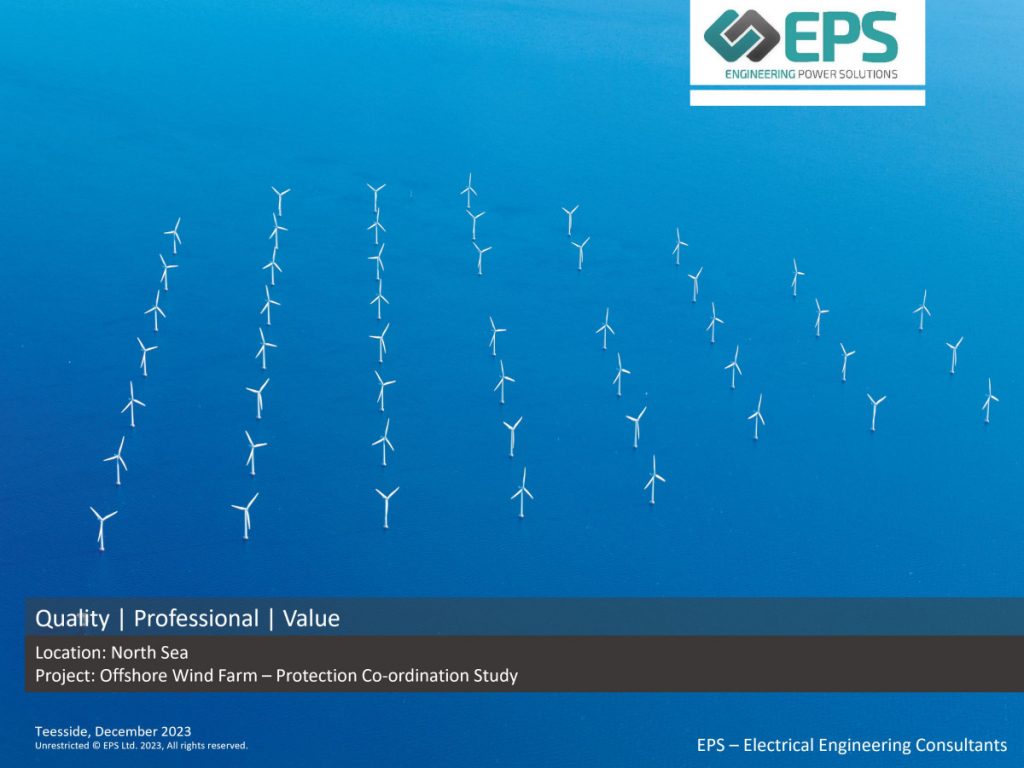Background
Client: Undisclosed
Industry: Renewable Energy – Offshore Wind Farm
Location: North Sea
Date: December 2023
Engineering Power Solutions, EPS was engaged by a large wind farm operator based in the North Sea to conduct a comprehensive review of the protection coordination within their wind farm. The primary objective was to assess the adequacy of the existing grading system in maintaining system stability during fault conditions.
The project also aimed to identify any potential enhancements which could improve the overall performance and reliability of the wind farm’s protection schemes.

Project Scope:
The study encompassed a large-scale wind farm comprising 174 wind turbines, a 400kV onshore substation, and two offshore substations equipped with four 180MVA grid transformers. The system also featured Siemens STATCOM reactive power technology along with an extensive network of 33kV subsea array cables.
Protection Schemes Analysed:
EPS conducted a thorough analysis of various protection schemes deployed within the wind farm, including:
- Time-overcurrent protection (definite-time/inverse-time/user-def.)
- Negative-sequence protection
- Sensitive earth-fault detection
- Breaker failure protection
- Intermittent earth-fault protection
- Displacement voltage
- Inrush restraint
- Under/overvoltage protection
- Overload protection
- Under/ over frequency protection
Methodology:
Our team of experts utilised advanced simulation software and industry-standard techniques to evaluate the existing protection coordination across the wind farm, including detailed fault analysis, performance assessment of each protection scheme, and identification of potential areas for improvement.
Findings and Recommendations:
Based on the comprehensive study, EPS provided the following findings and recommendations to enhance the wind farm’s protection coordination:
- Identified areas where the existing time-overcurrent protection settings required adjustment to ensure optimal coordination and fault clearance.
- Proposed enhancements to the sensitive earth-fault detection scheme to enhance system sensitivity and rapid fault detection.
- Recommended implementation of earth-fault protection schemes to minimise potential disruptions caused by intermittent earth faults.
- Advised on the optimisation of inrush restraint settings to prevent unnecessary tripping during transformer energisation.
- Proposed refined overload protection settings to improve system reliability and prevent overloading under varying operating conditions.
- Recommended enhancements to the negative-sequence protection scheme to mitigate the impact of unbalanced fault conditions.
- Proposed improvements to the breaker failure protection scheme to expedite fault isolation and improve system restoration.
- Provided recommendations to enhance the performance of the displacement voltage scheme for improved fault detection and protection coordination.
- Proposed adjustments to the under/overvoltage protection settings to ensure effective voltage control within desired operating limits.
- Advised on refined under/over frequency protection settings to maintain system stability during frequency deviations.
Outcome:
By implementing the recommendations provided by EPS, the client achieved enhanced protection coordination across their wind farm. The optimised protection schemes ensured improved stability and reliability during fault conditions, minimising potential disruptions and safeguarding the system’s integrity. EPS’s knowledge and thorough analysis were important in making sure the wind farm’s protection coordination met industry standards and best practices.
Conclusion:
EPS gained valuable insights and actionable recommendations from the in-depth review of the wind farm’s protection coordination. Our expertise in this domain, coupled with the utilisation of advanced simulation tools, empowered us to identify potential improvements and optimise the overall performance of the protection schemes.
EPS remains committed to delivering innovative solutions that enhance the operational efficiency and reliability of renewable energy projects, ensuring a sustainable and resilient future. To ensure the resilience of your electrical assets, connect with one of our experts today at 01642 987240, or drop us an email at enquiries@engineeringpowersolutions.co.uk










